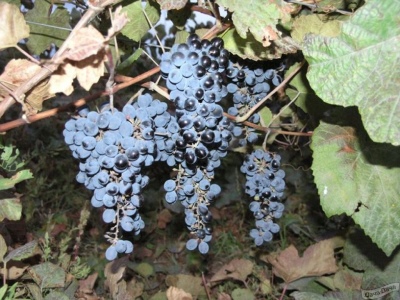
- Authors: Nizhne-Volzhskoe Research Institute, A. I. Potapenko, L. P. Potapenko
- Appointment: technical
- Berry color: black, with intense waxy bloom
- Taste: simple
- With bones: Yes
- Ripening period: early middle
- Frost resistance, ° C: -40
- Bunch weight, g: 180
- Density of the bunch: dense
- Appeared when crossing: Amur grapes x Amur grapes
There are not many grape varieties that really do well with harsh winters. But the Olenevsky variety belongs to just such. In this article, we will consider the history of breeding the variety, its peculiarity, fruits, agrotechnical aspects, frost resistance and shelf life.
Breeding history
The technical grape variety Olenevsky was bred by breeders L.P. Potapenko and A.I.Potapenko in 1986 at the Nizhne-Volzhsky Research Institute. To breed a hybrid, two varieties of Amur grapes were taken. The result is a mid-early technical grade that was not released to the market until 1991.
Other names of the variety are Olenevsky black, Black Potapenko, Olenevsky Potapenko.
Description
As mentioned earlier, the variety is medium early, used mainly for winemaking and juices.
The bushes are large, powerful and spreading. The vines usually twist and spread, although the clusters are lightweight, the branches still tilt towards the ground. Therefore, it is necessary to install a trellis support system. Shoots in a rosette are very close to each other, so when they grow, they form a dense wall. The vine has a rich brown color, there is peeling and pubescence.
Leaves are medium in size, medium-sized, the section is barely noticeable. The blades are practically absent, resembling wedge-shaped in shape. The upper surface is smooth, on the reverse side there are villi and terry. Bright green in color. In the fall, before falling off, the leaves turn yellow.
Fruiting of seedlings begins 3-4 years after planting branches in open ground.
Ripening period
Flowering begins in mid-May and ripens at the end of August. The ripening period for fruits is 130-140 days.
Bunches
Bunches are small, small, weighing only 180-200 g. Cylindrical, fruits are located tightly to each other.
Berries
The berries are round conical in shape. The shade is deep black, there is a gloss and a waxy coating. The berries weigh 1-2 g, considered a small variety. The pulp is juicy, fleshy, due to the rind it turns black. There are few seeds, small in size.
Suitable for machining only.
Taste
The taste is simple, no impurities. Good ratio of sugar and acidity.
Yield
Many gardeners report good and consistent yields.


Growing features
Seedlings can be planted in open ground both in the spring and in the fall. This variety has good wintering performance, so you should not wait for spring for planting.
It is necessary to choose the right place for disembarkation. This should be the sunny side of the site, preferably on a small hill. The soil should be loose, sandy and loamy. If there is a lot of clay in the selected area, then it is better to remove it and bring new earth.
Before planting, the site should be dug up with useful minerals and humus. This will renew the land, and it will be saturated with useful properties, which will then be given to the seedlings. After digging, the earth should be abundantly moistened and left for two weeks.
Grapes should not be planted where water or swampy areas accumulate. The roots of this variety do not tolerate too much moisture.
Landing
Before planting seedlings, it is necessary to dig holes and think over a trellis system. This is done immediately in order to properly tie up the creeping shoots after a while.
The size of the pits should be as follows: 0.8 m deep, 0.5 m in diameter. Drainage from broken bricks or pebbles is laid on the bottom, a small layer of fresh fertile soil is poured on top of it, along with minerals rich in nitrogen. After that, a seedling is planted. It must be healthy, the roots must be strong, have 2-3 buds and 3 shoots.
It is worth lowering the young shoot carefully, gradually covering the branch with earth. The earth must be tamped. Above ground level, it is worth leaving the root collar 2-4 cm. Spill the bushes abundantly with water. If desired, you can mulch the land around the bushes.

Pollination
Flowers in Olenevsky grapes of both sexes, pollination occurs independently and does not require additional intervention.
Pruning
Pruning is carried out in several stages. Spring pruning is carried out in order to remove dried branches, those that are broken or frozen in winter.
In the fall, it is necessary to cut the vine into 2-3 buds. Prune all vines that have been bearing fruit for more than 2-3 years. And those branches that have been damaged by the disease. It is worth pruning in the fall after all the leaves have fallen off.
All cuttings are carried out with a sharp pruner, and all cuts are processed with garden pitch.



Frost resistance and the need for shelter
The hybrid has a high frost resistance, practically -40 degrees. Therefore, it is not necessary to cover the vines, even in the northern regions. In the first year, the seedlings should be covered with agrofibre.

Diseases and pests
Olenevsky grapes have good indicators of resistance to a number of diseases and pests. Preventive measures should be taken once a year.

If a grape is exposed to any disease or insect, this always affects its appearance.
Storage
The variety has good transportability and a relatively long shelf life of up to 2 months.











































































